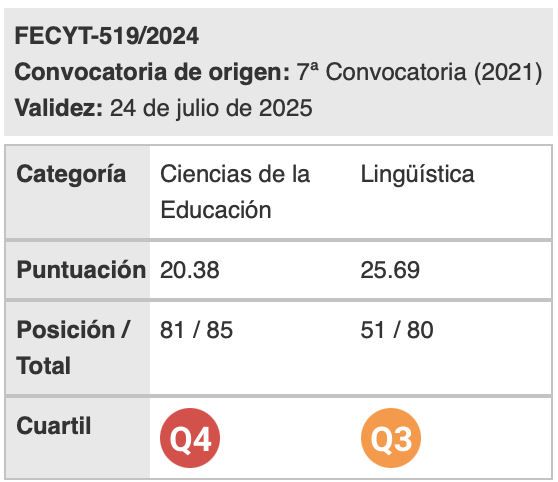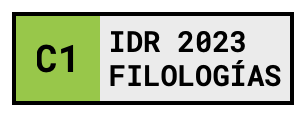The design and integration of ESP content in an upper-intermediate online course
Palabras clave:
ESP content, online language learning, courseware design, InGenio authoring tool, learner satisfactionResumen
Language instructors who adopt the role of materials writers in order to provide their students with more accurate tailor-made learning resources usually start by closely examining their learners’ needs and demands, as well as the distinctive features of the teaching context or situation in which those materials are going to be implemented. This idea is especially relevant when the linguistic resources are developed to be used by future engineers who access them to practice and learn a language that will have a dominant presence in their future working environment. This is a fact that encouraged the authors to design an online upper-intermediate level English course which incorporates relevant language resources directly linked to the disciplines and contents covered by their students’ university undergraduate degrees. The course is known as the InGenio FCE Online Course & Tester (Universidad Politécnica de Valencia, 2011).
The article illustrates how language instructors try to explore and find new ways, methods, typologies of exercises, and techniques which might help them create, promote, and implement learning systems capable of fostering an integral communicative competence and make the entire learning process more dynamic and attractive. A specific case study dealing with students who seek to make the most of combining Computer-Assisted Language Learning and English for Specific Purposes is described and analysed here.
The reader is presented with a description of the steps that were taken to design innovative and engaging online courseware to cater for the learners’ specific needs and the conclusions that have arisen from conducting a survey to analyse student perceptions and expectations prior to and after completing the said online course.
Descargas
Citas
Arnó Macià, E., Soler Cervera, A. and Rueda Ramos, C. (2006). The role of Information Technology in Languages for Specific Purposes: Some central issues. In Arnó Macià, E.; Soler Cervera, A. and Rueda Ramos, C. (Eds.), Information Technology in Languages for Specific Purposes: Issues and prospects. New York: Springer, pp. 3-13.
Brinton, D., Snow, A. and Wesche, M. (2003). Content-based second language instruction. Ann Arbor, MI: University of Michigan Press.
Chapelle, C. (2003). English language learning and technology: lectures on Applied Linguistics in the age of Information and Communication Technology. Amsterdam: John Benjamins Publishing Co.
Colpaert, J. (2013). The role and shape of speech technologies in well-designed language learning environments. In Badin, P. et al. (Eds.), Proceedings of SLaTE 2013 - Interspeech 2013 Satellite workshop on Speech and Language Technology in Education, Grenoble, France.
Council of Europe (2001). Common European Framework of Reference for Languages. Cambridge: Cambridge University Press.
Coyle, D., Hood, P. and Marsh, D. (2010). CLIL: Content and Language Integrated Learning. Cambridge: Cambridge University Press.
Dressen-Hammouda, D. (2008). Aligning EAP Writing pedagogies across European universities: A case study from France. In I. Fortanet-Gómez and C. A. Räisänen (Eds.), ESP in European higher education: Integrating language and content. Amsterdam: John Benjamins Publishing Co.
Dudley-Evans, T. and St. John, M. (1998). Developments in English for Specific Purposes: A multidisciplinary approach. Cambridge: Cambridge University Press.
Forester, L. (2011). Connecting with CALL: Using technology to connect language learners with other disciplines. In N. Arnold and L. Ducate (Eds.), Present and future promises of CALL: From theory and research to new directions in language learning. San Marcos, TX: CALICO Publications.
Gimeno Sanz, A. (2015). Analysing learner attitudes to learning ESP online with the InGenio Content Management System. Proceedings of the ESP Conference 2015: Synergies of Language Learning, University of Niš, Serbia.
Gimeno Sanz, A.; Martínez Sáez, A.; Sevilla Pavón, A. & de Siqueira Rocha, J.M. (2011). Fostering autonomy in pedagogically sound e-learning environment for learners of English for specific purposes. In Maruenda, S. & Clavel, B. (Eds.), Multiple Voices in Academic and Professional Discourse: Current Issues in Specialised Language Research, Teaching and New Technologies. Cambridge: Cambridge Scholar Publishing, pp. 547-560.
Gimeno Sanz, A. (2009a). Online Courseware Design and Delivery: The InGenio Authoring System. In González-Pueyo, I.; Foz Gil, C.; Jaime Siso, M. & Luzón Marco, M.J. (Eds.), Teaching Academic and Professional English Online. Bern: Peter Lang, pp. 83-105.
Gimeno Sanz, A. (2009b). How can CLIL benefit from the Integration of Information and Communications Technologies? In M. L. Carrió-Pastor (Ed.), Content and Language Integrated Learning: Cultural diversity. Bern: Peter Lang.
Gimeno Sanz, A. & de Siqueira, J.M. (2009). Designing feedback to support language acquisition using the InGenio authoring tool. In Uzunboylu, H. & Cavus, N. (Eds.), Procedia - Social and Behavioral Sciences, 1(1): 1239-1243. Proceedings of the 1st World Conference on Educational Sciences 2009. Science Direct. Elsevier. doi:10.1016/j.sbspro.2009.01.221
Gimeno Sanz, A. (2008). InGenio: A dedicated CALL authoring shell, content manager and courseware delivery platform. Aprendizaje de lenguas asistido por ordenador: herramientas de autor para el desarrollo de cursos a través de la web. Valencia: Editorial Universidad Politécnica de Valencia, pp. 93-117.
Gimeno Sanz, A. (2002). Call Software Design and Implementation: the template approach. Valencia: Editorial de la Universidad Politécnica de Valencia.
Hussin, V. (2006). Uncovering tasks and texts – Teaching ESP through online workshops. In Arnó Macià, E.; Soler Cervera, A. and Rueda Ramos, C. (Eds.), Information Technology in Languages for Specific Purposes: Issues and Prospects. New York: Springer, pp. 91-104.
Keller, J., & Suzuki, K. (2004). Learner motivation and e-learning design: A multinationally validated process. Journal of Educational Media, 29(3), 229-239.
Liao, L. F. (2006). A flow theory perspective on learner motivation and behavior in distance education. Distance Education, 27(1), 45-62.
Lim, D. H., & Kim, H. (2003). Motivation and learner characteristics affecting online learning and learning application. Journal of Educational Technology Systems, 31(4), 423-439.
Luzón, M. J. (2009). Learning academic and professional English online: Integrating technology, language learning and disciplinary knowledge. In González-Pueyo, I.; Foz Gil, C.; Jaime Siso, M. and Luzón Marco, M. J. (Eds.), Teaching academic and professional English online. Bern: Peter Lang, pp. 11-33.
Martínez Sáez, A. (2015). Materiales online para el aprendizaje y la evaluación del inglés: análisis, diseño, propuesta y validación de recursos (Unpublished Doctoral Thesis).
Mungra, P. (2009). Online delivery of a writing course: Description of a blended language course integrated into Medicine. In González-Pueyo, I.; Foz Gil, C.; Jaime Siso, M. & Luzón Marco, M.J. (Eds.), Teaching Academic and Professional English Online. Bern: Peter Lang.
Palalas, A. (2010). ESP for busy adult students: Is the blend of mobile and online learning the answer? In Gimeno, A. (Ed.), New trends in Computer-Assisted Language Learning: Working together. London: Macmillan ELT, pp. 237-242.
Peacock, M. (1997). The effect of authentic materials on the motivation of EFL learners. ELT journal, 51(2), 144-156.
Räisänen, C. and Fortanet-Gómez, I. (2008). The state of ESP teaching and learning in Western European higher education after Bologna. In I. Fortanet-Gómez and C. A. Räisänen (Eds.), ESP in European higher education: Integrating language and content. Amsterdam: John Benjamins Publishing Co., pp. 11-51.
Rodgers, D. L., & Withrow-Thorton, B. J. (2005). The effect of instructional media on learner motivation. International Journal of Instructional Media, 32(4), 333.
Sevilla Pavón, A., Martínez Sáez, A. and de Siqueira Rocha, J. M. (2011). In S. Thouësny and L. Bradley (Eds.), Second Language Teaching and Learning with Technology: Views of Emergent Researchers. Dublin: Research-publishing.net, pp. 45-69.
White, C. (2009). Language learning in distance education. Cambridge: Cambridge University Press.
Wilkinson, R. (2008). Locating the ESP space in problem-based learning: English-medium degree programmes from a post-Bologna perspective. In I. Fortanet-Gómez and C. A. Räisänen (Eds.), ESP in European higher education: Integrating language and content. Amsterdam: John Benjamins Publishing Co., pp. 55-73.
Descargas
Publicado
Cómo citar
Número
Sección
Licencia
Aquellos autores/as que tengan publicaciones con esta revista, aceptan los términos siguientes:
- Los autores/as conservarán sus derechos de autor y garantizarán a la revista el derecho de primera publicación de su obra, el cuál estará simultáneamente sujeto a la Licencia de reconocimiento de Creative Commons que permite a terceros compartir la obra siempre que se indique su autor y su primera publicación esta revista.
- Los autores/as podrán adoptar otros acuerdos de licencia no exclusiva de distribución de la versión de la obra publicada (p. ej.: depositarla en un archivo telemático institucional o publicarla en un volumen monográfico) siempre que se indique la publicación inicial en esta revista.
- Se permite y recomienda a los autores/as difundir su obra a través de Internet (p. ej.: en archivos telemáticos institucionales o en su página web) antes y durante el proceso de envío, lo cual puede producir intercambios interesantes y aumentar las citas de la obra publicada. (Véase El efecto del acceso abierto).

Revista de Lenguas para fines específicos is licensed under a Creative Commons Reconocimiento-NoComercial-SinObraDerivada 4.0 Internacional License.






















